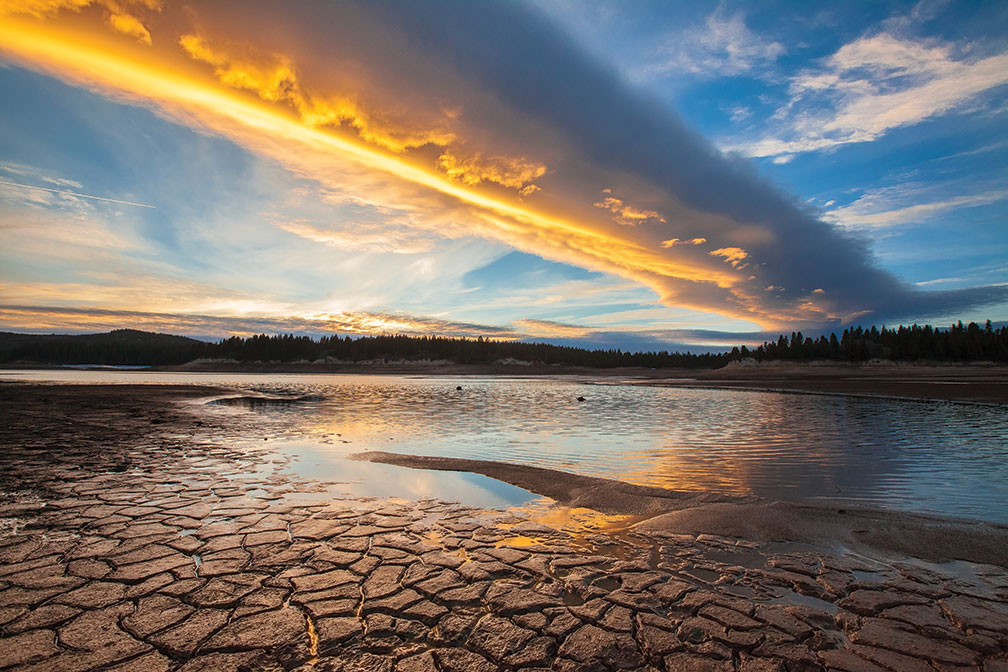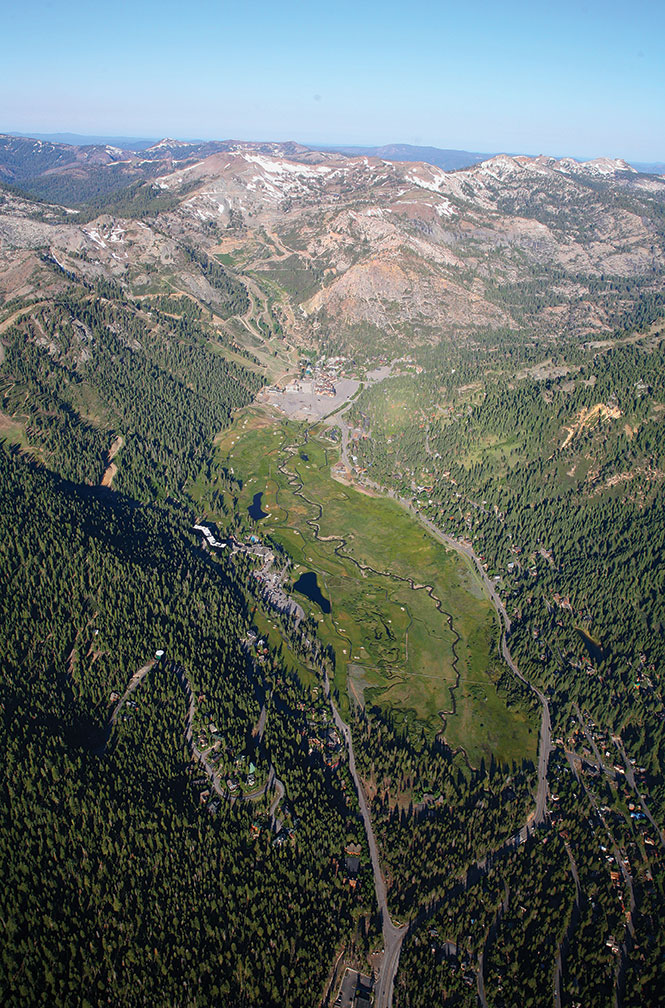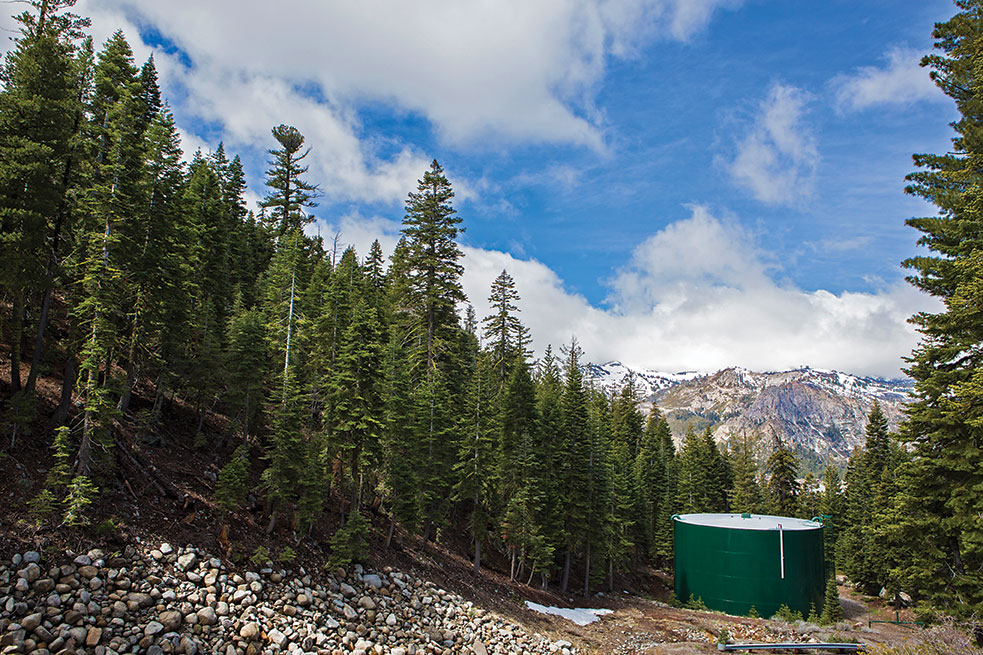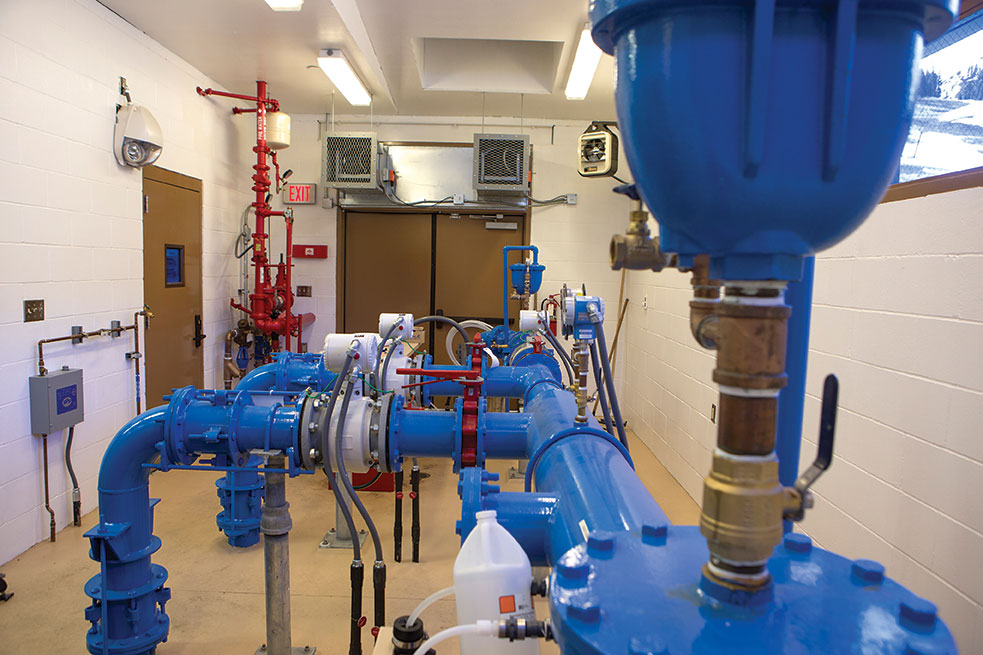
18 Dec The Growing Groundwater Debate
The third year of deep drought gives Tahoe and Truckee a glimpse into the future of groundwater in the age of climate change
The pumps to Squaw Valley’s four main wells have just kicked off as Brandon Burks enters the pumphouse sitting like an island in the middle of Squaw Valley’s expansive asphalt parking lot.
Outside, a spring drizzle just stopped falling. The snow caking the peaks ringing Squaw Valley is melting under the May sun, cascading down to an aquifer brimming with spring runoff.
Burks, an operations specialist with the Squaw Valley Public Service District, checks the computer screen monitoring the four pumps sucking about 1,270 gallons of water from the earth each minute and pushing it up to a million-gallon water tank perched above the northwest side of the valley.
Just feet down the valley from where Burks stands, an old fault splits the aquifer, making all of the downstream groundwater so mineral-laden it is undrinkable. So it is this small patch of ground, capped in asphalt, that bears the burden of producing the millions of gallons of water needed to quench Squaw Valley’s thirst during a long summer in the third year of one of the most severe droughts in California’s history.
Squaw’s pint-sized aquifer is one small piece of a California groundwater system under increasing strain and intense scrutiny after three dismal winters. As severe drought grips the state, a warming climate promises to shrink the Sierra Nevada snowpack and water needs continue to mount, aquifers across the state are being sucked worryingly low under the burden of quenching a thirsty California.
The colliding forces of climate change, development, golf course irrigation and snowmaking are groundwater strains Tahoe-Truckee water managers are not ignoring. Mike Geary, general manager of the Squaw Valley Public Service District, calls the Squaw Valley aquifer the most studied in the mountain range.
“There is not a more evaluated aquifer in the whole Sierra Nevada than this one. I guarantee it,” says Geary.
Squaw Valley’s big brother, the Martis Valley aquifer, is also undergoing extensive study. Researchers from Lawrence Livermore National Laboratory (LLNL) in Livermore, California, and various regional research organizations are trying to understand the aquifer’s potential to withstand climate change, how water recharges into the ground and how much well pumping affects stream flows.
As the historic drought continues, this information will help water managers understand the balance between the hundreds of millions of gallons of water they suck from the ground and the spring snowmelt that sends a surge of new water into these underground reservoirs. Most of all, it will help piece together the answer to the enormously important unanswered question lingering in every forward-thinking water manager’s mind: As Sierra Nevada winters warm, turn to rain rather than snow and become more unpredictable, is all this groundwater pumping sustainable?
The Underground Life of Water
Tahoe’s surface water cycle is well known. A prodigious snowpack melts into rivulets and streams, eventually flowing into the Truckee River and beginning a long journey east to the terminal desert expanse of Pyramid Lake.
But each spring, billions of gallons of water take a different, subterranean path. It is a journey that is not completely understood even by researchers and water managers. Yet this underground water is the regional economy’s lifeblood, powering everything from showerheads and faucets to snowmaking guns and golf course sprinklers.
Just like water rushes through the arteries of a river drainage, Tahoe’s unseen water system is a complex and interconnected web of aquifers. Snowmelt flows into vast underground vaults of glacial sand and gravel each spring. It pools in reservoirs hundreds of feet below ground. Some of the water has remained trapped in these subterranean soils since the days of the Roman Empire. Other water flushes through an aquifer in mere months or a couple short years.
This underground bounty of water is perforated by dozens of wells through which, each year, hundreds of millions of gallons are sucked above ground to feed the Tahoe-Truckee region’s thirst. The water is pushed through snow guns, billowing into man-made snow during fickle winters. It is the moisture that greens the fairways of the region’s many golf courses. And it is used to water nearly every lawn, flush nearly every toilet and fill nearly every bath in the Tahoe-Truckee area.
A Tale of Two Aquifers
The Squaw Valley and Martis Valley aquifers have almost nothing in common. Squaw Valley’s aquifer is about one square mile in size, and about 75 to 150 feet deep. Projections and water models forecast that if the valley reached “buildout”—if every piece of undeveloped land in the valley was developed to its full potential—the aquifer would strain and perhaps fail to meet the water demands of local residents.
The Martis Valley aquifer is large, deep and appears to be under no strain. The Martis groundwater basin covers 57 square miles, wells reach depths of more than 1,000 feet and water suppliers pump approximately 8.3 million gallons of water out of the aquifer daily through 20 wells.
While Squaw Valley’s wells produce between 100 and 420 gallons of water per minute, the single highest producing well in the Martis Valley spouts more than 2,400 gallons per minute.
The age of the water in the two aquifers also sets them apart. Squaw Valley is filled with young water that races down the granite slopes of the ski resort, saturates the aquifer and flushes out into the Truckee River or is sucked up by wells. The water flowing out of a Squaw Valley home’s faucet is typically only one or two years old.
The deepest parts of Martis Valley’s aquifer hold water that is several thousand years old. A team of researchers led by California State University, East Bay professor and LLNL researcher Jean Moran found that this ancient water is being tapped into by production wells across the Martis Valley.
Moran dated the water through an isotope aging process that tracks the degradation of tritium isotopes into helium-3 in the groundwater. Once water filters below ground and is separated from the earth’s atmosphere, the decay of these isotopes marks the age of the water.
Moran also found isotopes that can help researchers track the underground movement of water within the aquifer. Groundwater passing across the Polaris earthquake fault on the southeast side of the valley picks up terrigenic helium, a unique element originating in the earth’s mantle. This unique chemical signature allows researchers to pinpoint how groundwater flows or pools in a vast network of volcanic rock, alluvial sediment, layers of clay and rock remnants from glacial scouring.
So far, Moran’s study has highlighted the dual identity of the Martis Valley aquifer. On one hand, the deep aquifer contains water that has pooled into the deepest reaches of this underground reservoir and stayed there for thousands of years. At the same time, the shallow aquifer of the Martis Valley is full of young water that is constantly recharged by spring snowmelt.
“The shallow system is pretty dynamic,” says Moran.
But he warns, the shallow portion of the aquifer may be more susceptible to impacts from climate change. And the oldest, deepest parts of the aquifer recharge at much slower rates.
“The age of the water tells you how long it takes to get there,” says Moran.

With more development planned for Squaw Valley, it’s possible businesses and residents
will be forced to look elsewhere for water as the historic valley’s groundwater is under
strain, photo by Ryan Salm
The Wild West No More?
A web of regulation governs California’s surface water, but groundwater is essentially a free-for-all. In most water basins, landowners can simply drill a well and pump as much water as possible from the ground.
This laissez-faire attitude toward one of the state’s more precious resources has resulted in dramatic impacts. In California’s San Joaquin Valley, the intense overdrafting of the water basin in the mid-twentieth century caused the valley floor to drop by more than 28 feet in some places as the land collapsed over the vacuum created by the evacuation of the aquifer.
The U.S. Geological Survey called this sinking of the valley floor, “one of the single largest alterations of the land surface attributed to humankind.”
Now, a new study published in the journal Nature and led by a researcher at Western Washington University says that groundwater pumping in California’s Central Valley has actually caused the Sierra Nevada and California Coast mountain ranges to rise, and has put new stresses on the state’s earthquake faults. The earth’s crust is surprisingly elastic, the report says, and the heavy load of winter’s snowpack actually subtly depresses the Sierra Nevada, while subtly swelling the Central Valley floor during snowmelt in spring. Over the last 150 years, as the equivalent of the entire volume of Lake Tahoe has been sucked from the ground in the Central Valley without replenishment, the Central Valley has permanently dropped while the mountains have inched higher, according to the study.
This new science, and the severity of the ongoing drought, is intensifying the drumbeat for California to regulate groundwater usage. As California landowners engage in a drilling frenzy to punch new wells and increase the depth of existing wells—in groundwater grabs one landowner called “a race to the bottom”—California lawmakers are inching closer to statewide regulation of groundwater.
The newly formed California Water Foundation is lobbying for sustainable groundwater management, and California Senator Fran Pavley (D–Agoura Hills) introduced legislation at the end of April calling for local and regional groundwater management and authorizing the state water resources control board to manage groundwater under certain conditions.
“With 38 million people and a warming climate, California is pushing up against the limits of our finite water supply,” Pavley said in a statement. “Meeting the challenges of the future will require more reliable, sustainable approaches to water and greater regional self-sufficiency.”
In many ways, Tahoe and Truckee are a world away from these water wars. The Truckee River watershed is on the east slope of the Sierra Nevada, sending water into Nevada rather than California. The region’s position at the upper reaches of the watershed is an enviable location at the top of the water system food chain. While Tahoe-Truckee is experiencing drought conditions, there is no current water shortage, says Steven Poncelet of the Truckee Donner Public Utility District.
But the Truckee River system is more than Tahoe-Truckee’s personal water supply. The water has increasing demands, ranging from irrigation supply for Nevada farmers to river flows impacting the ecological health of Pyramid Lake.
“There is a finite amount of water in the Truckee River Basin system and that water is being counted on to meet the needs of Lake Tahoe, Truckee, Reno and Nevada,” says Poncelet.

A water tank in Squaw Valley, where developers may need to source water from elsewhere
in the region to keep up with a planned increase in demand, photo by Ryan Salm
A Village Plan and a Possible Pipeline
Squaw Valley Public Utility District’s Geary is a water manager with a duty to provide safe, reliable, clean water to the homeowners and businesses in his district. At the same time, he is not blind to the politics of his current position as the largest water provider in a water-constrained valley on the verge of major development.
Squaw Valley Ski Holdings, the owners and operators of Squaw Valley Ski Resort, are deep into plans to build 750 new condominiums and a 90,000 square foot water and adventure park at the base of the resort. Whether Squaw Valley has the water to supply the development is still an open question.
“We’ve been saddled with the responsibility of getting blood from a stone,” says Geary.
A water assessment will soon be completed detailing whether the district can supply water to the project through existing wells, or by punching new wells in the small water-bearing portion of the upper aquifer. But the district has long been looking beyond its aquifer and planning for a backup water supply from Martis Valley.
Piping water in from Martis Valley is an idea that pre-dates the Squaw Village plan, but the timing of the two projects has increased the scrutiny of the pipeline proposal. The district is investigating either purchasing property in Martis Valley, pumping groundwater from that property and then piping it down the Truckee River to Squaw Valley, or engaging in a partnership with existing water providers in the Truckee and Martis Valley area to supply the water, Geary says.
Geary sees the pipeline as an opportunity to provide a vital backup to Squaw’s water supply, allowing the district to serve residents in the case of a contamination of the aquifer or a failure of the pumping system. And it would allow a partnership that could build a natural gas pipeline, fiber-optic services and a bike path down the Truckee River canyon along with the water pipeline.
Given current demands on the Martis Aquifer, the groundwater basin south of Truckee appears to be more than capable of providing backup supply to Squaw Valley. The total water usage in Martis Valley is 9,341 acre feet (the volume of water that would cover one acre to the depth of one foot) annually—about 3 billion gallons of water. The aquifer recharges at a rate of between 18,000 and 35,000 acre feet per year, according to estimates—meaning that up to 11 billion gallons of water flows back into the aquifer.
However, the timing of the pipeline coinciding with the controversial village development proposal makes it a highly charged topic.
“It has made our job a lot harder because of the perception that they are connected,” says Geary of the pipeline plan and the development proposal.

A look inside Squaw Valley’s water treatment plant, photo by Ryan Salm
The Climate Change Question Mark
Climate projections paint a grim picture of the future Sierra Nevada snowpack. The deep winter snows—a vital frozen reservoir that time-releases into rivers each spring and summer—is expected to decrease by 25 percent over the next 35 years, according to the California Department of Water Resources. Some projections are even gloomier, forecasting that between 70 and 90 percent of the Sierra snowpack will vanish by the end of the century.
The shrinking Sierra Nevada snowpack will set off a chain reaction of downstream problems. Spring runoff will begin earlier and feed less water into river systems each summer. Just as the hotter weather increases the demand for water, there will be less water to go around.
“Decreasing snowmelt and spring stream flows coupled with increasing demand for water resulting from both a growing population and hotter climate could lead to increasing water shortages,” reads a California Climate Change Center report released in 2006.
The outlook for groundwater is equally bleak. Droughts will become more frequent, and when precipitation does fall it will come more often in floods. The rapid runoff during these deluges will rush off mountain slopes before adequately recharging aquifers, according to the Martis Valley Groundwater Management Plan.
These diverging trend lines—the increased demand for water in a hot and dry future and the reduced water supply in a climate with less snow and more drought—have their own twist in Tahoe. Tahoe ski resorts are beefing up snowmaking systems to hedge against increasingly unreliable winters.
The Martis Valley Groundwater Management Plan gives a clear picture of the current groundwater demands of Northstar California’s snowmaking system. According to the report, more than 191 million gallons of water were used to make snow on the mountain in the winter of 2011.
Snowmaking’s impact on groundwater is complex. If the winter snowpack continues to dwindle, the demand for snowmaking will continue to rise. Coupled with potentially depleted aquifers under climate change conditions, this could be a significant future strain on groundwater resources. But water managers point out that much of the groundwater used to make snow returns to the system each year as snowmelt, recharging the aquifer from whence it came. In Nevada, Diamond Peak received an 80 percent “snowmaking credit” for its snowmaking water use, under the assumption that 80 percent of the water used to make snow returns to Lake Tahoe or the local aquifer.
But snowmaking is only one intense use of the groundwater. Not long after snowmaking shuts down for the season, golf course irrigation kicks in. In Martis Valley, an average of 665 million gallons of water is used each summer to irrigate golf courses, according to the Martis groundwater plan. Unlike snowmaking, the majority of this water does not return to the system, instead sucked up by grass roots or evaporated by the sun
Climate change is a tricky topic for Tahoe water managers. While they know it will drastically impact future operations and have partnered to study the issue, they are making few concrete operations and planning decisions based on climate projections.
“We are keenly interested in it, but at the same time unable to respond to it because of a lack of understanding of what those impacts will be,” says Geary. “We can’t constrict the use of water because of things we don’t know.”
Moran, who spent two summers studying groundwater in the Martis Valley, says all well owners were very willing to aid her in her study. For some, the conclusions of the climate change studies might be uncomfortable. But that has not stopped them from allowing testing at their wells or contributing data to the study.
“We applaud everyone’s efforts to study it,” says Geary. “But we don’t know how to respond to it except to be conservative in our projections.”
Being conservative means conserving the water the district does pump from the aquifer. The Truckee Donner Public Utility District has reduced water production by 30 percent since 2008 through a combination of pipe leak repairs and water meters. And, the Squaw Valley Public Service District alters its pumping schedule in late summer and fall to lessen the load on the aquifer.
But three years of drought gave Tahoe a glimpse into what tough decisions the future may hold for water managers in a climate change–challenged future. Tahoe remains in an advantageous spot atop the watershed, and has dodged the serious water crisis gripping the Central Valley. But the cautionary tales of overdrafted aquifers, collapsing valley floors and brewing water wars coming from valleys to the west can serve as a lesson in groundwater mistakes for the Sierra Nevada.
“Water has been an issue for California going back a long, long time,” says Geary. “When you bring on more and more demand, supply has to come from somewhere. You go for that lower-hanging fruit and then you pick that high-hanging fruit and pretty soon there is not going to be any more fruit on the tree.”
David Bunker is a Truckee-based writer and editor.




No Comments